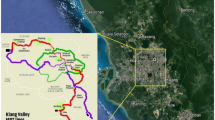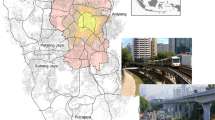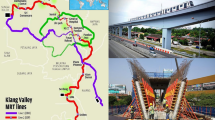Abstract
Pile settlement (SP) socketed to rock has taken substantial regard. Despite introducing some design techniques of SP, employing the novel and workable prediction model with acceptable prediction performance is pivotal. The basic target of the present paper is to find out the applicability of applying two hybrid biogeography-based support vector regressions (BBO-SVR) and ant lion optimization-support vector regression (ALO-SVR) in predicting the SP in the Klang Valley Mass Rapid Transit (KVMRT) project constructed and operated in Kuala Lumpur, Malaysia. To apply the hybrid methods, the records of pile driving analyzer tests, piles, and earth’s properties were considered. Comparing the recorded SP with predicted values by ALO-SVR and BBO-SVR are supplied that the developed models have R2 larger than 0.9994. Considering all statistical evaluators, it could be concluded that both hybrid models are really capable of predicting SP. However, ALO-SVR represents a higher ability in determining the optimal value of the SVR parameters than BBO-SVR.









Similar content being viewed by others
References
Alemdag S, Gurocak Z, Cevik A, Cabalar AF, Gokceoglu C (2016) Modeling deformation modulus of a stratified sedimentary rock mass using neural network, fuzzy inference and genetic programming. Eng Geol 203:70–82
Al-Fugara A, Ahmadlou M, Al-Shabeeb AR, AlAyyash S, Al-Amoush H, Al-Adamat R (2020) Spatial mapping of groundwater springs potentiality using grid search-based and genetic algorithm-based support vector regression. Geocarto Int. https://doi.org/10.1080/10106049.2020.1716396
Alkroosh I, Nikraz H (2011) Correlation of pile axial capacity and CPT data using gene expression programming. Geotech Geol Eng 29:725–748
Armaghani DJ, Amin MFM, Yagiz S, Faradonbeh RS, Abdullah RA (2016) Prediction of the uniaxial compressive strength of sandstone using various modeling techniques. Int J Rock Mech Min Sci 85:174–186
Armaghani DJ, Faradonbeh RS, Rezaei H, Rashid ASA, Amnieh HB (2018) Settlement prediction of the rock-socketed piles through a new technique based on gene expression programming. Neural Comput Appl 29:1115–1125
Armaghani DJ, Asteris PG, Fatemi SA, Hasanipanah M, Tarinejad R, Rashid ASA, Van Huynh V (2020) On the use of neuro-swarm system to forecast the pile settlement. Appl Sci 10:1904
Benemaran RS, Esmaeili-Falak M (2020) Optimization of cost and mechanical properties of concrete with admixtures using MARS and PSO. Comput Concr 26:309–316. https://doi.org/10.12989/cac.2020.26.4.309
Carrubba P (1997) Skin friction on large-diameter piles socketed into rock. Can Geotech J 34:230–240
Dindarloo SR (2015) Prediction of blast-induced ground vibrations via genetic programming. Int J Min Sci Technol 25:1011–1015
Esmaeili Falak M, Sarkhani Benemaran R, Seifi R (2020) Improvement of the mechanical and durability parameters of construction concrete of the Qotursuyi Spa. Concr Res 13:119–134. https://doi.org/10.22124/JCR.2020.14518.1395
Esmaeili-choobar N, Esmaeili-falak M, Roohi-hir M, Keshtzad S (2013) Evaluation of collapsibility potential at Talesh, Iran. EJGE 2561–2573
Esmaeili-Falak M (2017) Effect of system’s geometry on the stability of frozen wall in excavation of saturated granular soils. Doctoral dissertation, University of Tabriz
Esmaeili-Falak M, Katebi H, Javadi A, Rahimi S (2017) Experimental investigation of stress and strain characteristics of frozen sandy soils-a case study of Tabriz subway. Modares Civ Eng J 17:13–23
Esmaeili-Falak M, Katebi H, Javadi A (2018) Experimental study of the mechanical behavior of frozen soils-a case study of tabriz subway. Period Polytech Civ Eng 62:117–125
Esmaeili-Falak M, Katebi H, Vadiati M, Adamowski J (2019) Predicting triaxial compressive strength and Young’s modulus of frozen sand using artificial intelligence methods. J Cold Reg Eng 33:4019007. https://doi.org/10.1061/(ASCE)CR.1943-5495.0000188
Esmaeili-Falak M, Katebi H, Javadi AA (2020) Effect of freezing on stress-strain characteristics of granular and cohesive soils. J Cold Reg Eng 34:05020001. https://doi.org/10.1061/(ASCE)CR.1943-5495.0000205
Hatheway AW (2009) The complete ISRM suggested methods for rock characterization, testing and monitoring; 1974–2006
Khandelwal M, Singh TN (2007) Evaluation of blast-induced ground vibration predictors. Soil Dyn Earthq Eng 27:116–125
Le T-T, Le MV (2021) Development of user-friendly kernel-based Gaussian process regression model for prediction of load-bearing capacity of square concrete-filled steel tubular members. Mater Struct 54:1–24
Le Tirant P (1992) Design guides for offshore structures: offshore pile design
Maghsoodi V, Atermoghaddam F, Esmaeili-Falak M (2013) Parametric and two dimensional study of seismic behavior of micro pile group in sandy soil. Int Res J Appl Basic Sci 6:901–909
Mirjalili S (2015) The ant lion optimizer. Adv Eng Softw 83:80–98
Moayedi H, Kalantar B, Foong LK, Tien Bui D, Motevalli A (2019) Application of three metaheuristic techniques in simulation of concrete slump. Appl Sci 9:4340
Mollahasani A, Alavi AH, Gandomi AH (2011) Empirical modeling of plate load test moduli of soil via gene expression programming. Comput Geotech 38:281–286
Momeni E, Nazir R, Armaghani DJ, Maizir H (2015) Application of artificial neural network for predicting shaft and tip resistances of concrete piles. Earth Sci Res J 19:85–93
Momeni E, Dowlatshahi MB, Omidinasab F, Maizir H, Armaghani DJ (2020) Gaussian process regression technique to estimate the pile bearing capacity. Arab J Sci Eng 45:8255–8267
Nejad FP, Jaksa MB, Kakhi M, McCabe BA (2009) Prediction of pile settlement using artificial neural networks based on standard penetration test data. Comput Geotech 36:1125–1133
Ng CWW, Yau TLY, Li JHM, Tang WH (2001) Side resistance of large diameter bored piles socketed into decomposed rocks. J Geotech Geoenvironmental Eng 127:642–657
Ozbek A, Unsal M, Dikec A (2013) Estimating uniaxial compressive strength of rocks using genetic expression programming. J Rock Mech Geotech Eng 5:325–329
Pal M, Deswal S (2010) Modelling pile capacity using Gaussian process regression. Comput Geotech 37:942–947
Poorjafar A, Esmaeili-Falak M, Katebi H (2021) Pile-soil interaction determined by laterally loaded fixed head pile group. Geomech Eng 26:13–25. https://doi.org/10.12989/gae.2021.26.1.013
Randolph MF, Wroth CP (1978) Analysis of deformation of vertically loaded piles. J Geotech Eng Div 104:1465–1488
Rezaei H, Nazir R, Momeni E (2016) Bearing capacity of thin-walled shallow foundations: an experimental and artificial intelligence-based study. J Zhejiang Univ Sci A 17:273–285
Rowe RK, Armitage HH (1987) A design method for drilled piers in soft rock. Can Geotech J 24:126–142
Samui P (2019) Determination of friction capacity of driven pile in clay using Gaussian process regression (GPR), and minimax probability machine regression (MPMR). Geotech Geol Eng 37:4643–4647
Sarkhani Benemaran R (2017) Experimental and analytical study of pile-stabilized layered slopes. Thesis, University of Tabriz
Sarkhani Benemaran R, Esmaeili-Falak M, Katebi H (2020) Physical and numerical modelling of pile-stabilized saturated layered slopes. Proc Inst Civ Eng Geotech Eng. https://doi.org/10.1680/jgeen.20.00152
Shahin MA, Maier HR, Jaksa MB (2002) Predicting settlement of shallow foundations using neural networks. J Geotech Geoenvironmental Eng 128:785–793
Simon D (2008) Biogeography-based optimization. IEEE Trans Evol Comput 12:702–713
Soleimanbeigi A, Hataf N (2006) Prediction of settlement of shallow foundations on reinforced soils using neural networks. Geosynth Int 13:161–170
Teodorescu L, Sherwood D (2008) High energy physics event selection with gene expression programming. Comput Phys Commun 178:409–419
Vapnik V (2013) The nature of statistical learning theory. Springer Science & Business Media, Berlin
Wang L (2005) Support vector machines: theory and applications. Springer Science & Business Media, Berlin
Yagiz S, Sezer EA, Gokceoglu C (2012) Artificial neural networks and nonlinear regression techniques to assess the influence of slake durability cycles on the prediction of uniaxial compressive strength and modulus of elasticity for carbonate rocks. Int J Numer Anal Methods Geomech 36:1636–1650
Zhang WG, Goh ATC (2013) Multivariate adaptive regression splines for analysis of geotechnical engineering systems. Comput Geotech 48:82–95
Author information
Authors and Affiliations
Corresponding author
Additional information
Publisher's Note
Springer Nature remains neutral with regard to jurisdictional claims in published maps and institutional affiliations.
Rights and permissions
About this article
Cite this article
Zhang, Y. Pile settlement prediction applying hybrid ALO-SVR and BBO-SVR approaches. Multiscale and Multidiscip. Model. Exp. and Des. 5, 243–253 (2022). https://doi.org/10.1007/s41939-022-00115-y
Received:
Accepted:
Published:
Issue Date:
DOI: https://doi.org/10.1007/s41939-022-00115-y




